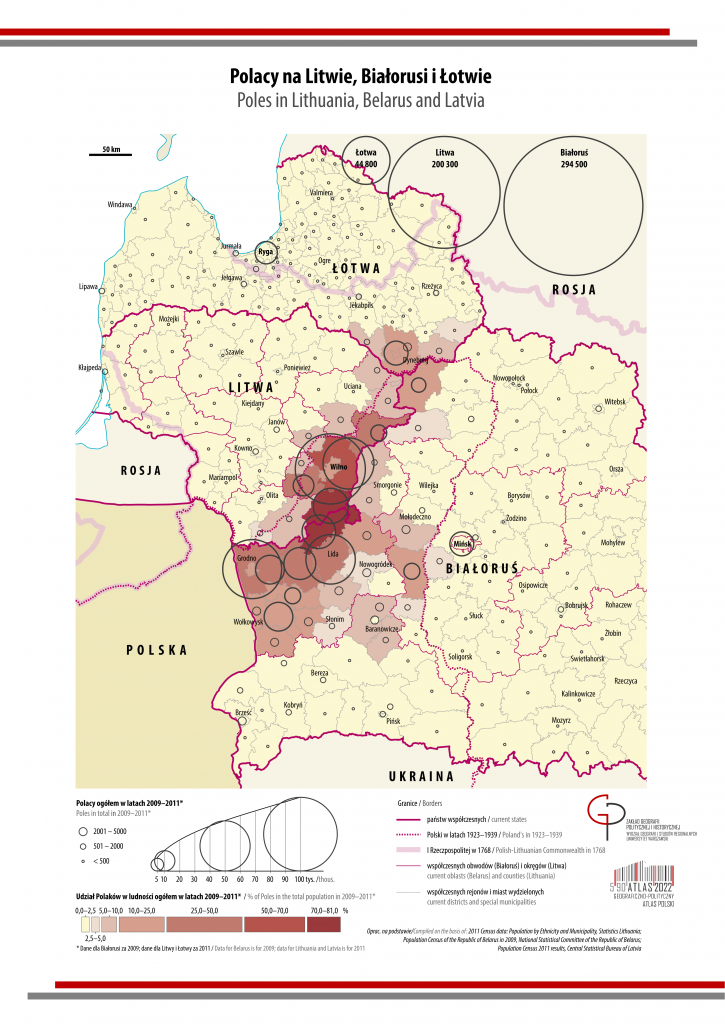Map of Polish Population in Lithuania, Belarus, and Latvia


Alex Cartwright
Senior Cartographer & GIS Specialist
Alex Cartwright is a renowned cartographer and geographic information systems specialist with over 15 years of experience in spatial analysis and data...
Geographic Analysis
What This Map Shows
The map titled 'Polish Population in Lithuania, Belarus, and Latvia' provides a visual representation of the distribution of Polish communities across these three Baltic states. It highlights areas with significant concentrations of Polish people, showcasing historical migration patterns, cultural enclaves, and demographic shifts that have shaped the region over the years. This map not only serves as a geographical tool but also opens a window into the rich tapestry of cultural interactions and influences that define these neighboring countries.
Deep Dive into Polish Communities in the Baltic States
The Polish presence in Lithuania, Belarus, and Latvia is deeply rooted in history, reflecting centuries of migration, political changes, and cultural exchange. In Lithuania, for instance, the Polish population is primarily concentrated in the capital city of Vilnius and the surrounding regions. Historically part of the Grand Duchy of Lithuania, these areas have maintained a strong Polish cultural influence, which is evident in local traditions, language, and even architectural styles. Interestingly, about 6.5% of Lithuania's population identifies as Polish, a testament to the enduring legacy of Polish heritage in the region.
Moving to Belarus, the Polish community, although smaller than in Lithuania, has played a significant role in the country's cultural landscape. Areas such as Grodno and Brest are known for their historical Polish influence. The Polish language and customs are still celebrated in these regions, particularly through festivals and educational institutions that promote the Polish heritage. This is particularly notable in Grodno, where Polish schools have been established, and cultural organizations actively work to preserve Polish traditions.
Latvia presents a somewhat different picture. The Polish population here is less concentrated, but it still forms an essential part of the multicultural identity of the country. Cities like Daugavpils and Rēzekne have seen Polish communities that contribute to the local economy and cultural diversity. What's fascinating is that despite facing challenges such as language barriers and political tensions, Polish Latvians have managed to maintain their cultural identity through community events and language schools.
The demographic patterns of these Polish populations have been influenced by significant historical events, including the partitions of Poland, World War II, and the subsequent Soviet era. Each of these events led to waves of migration and shifts in population distribution, ultimately shaping the modern demographic landscape we see today.
Regional Analysis
Examining the regional differences in Polish populations across Lithuania, Belarus, and Latvia reveals intriguing contrasts. In Lithuania, for example, the Polish community is more integrated into the political fabric, with representatives elected to local and national parliaments. This strong presence allows for better advocacy of their rights and cultural recognition.
Conversely, in Belarus, the Polish community faces more challenges. After the fall of the Soviet Union, the Polish minority has struggled with issues related to language rights and political representation. The Belarusian government has historically been cautious about ethnic minorities, which sometimes limits the Polish community's ability to flourish compared to their counterparts in Lithuania.
In Latvia, while the Polish community is smaller, it tends to be more dispersed. The lack of a substantial urban concentration means that Polish cultural influences are often intermingled with those of other ethnic minorities, enriching the overall cultural landscape but diluting distinct Polish identity in some areas. However, community organizations work tirelessly to promote Polish culture and maintain the language, ensuring that the heritage continues to be passed down through generations.
Significance and Impact
Understanding the distribution of the Polish population in these three Baltic states is crucial for recognizing the broader implications of cultural diversity and minority rights in Eastern Europe. The Polish communities contribute significantly to the social, economic, and cultural dynamics of Lithuania, Belarus, and Latvia. As globalization continues to influence migration patterns, the future of these communities will rely heavily on the balance between cultural preservation and integration into the national identity.
Current trends suggest that as younger generations become more mobile, they may seek opportunities in larger urban centers, potentially leading to further demographic shifts. Additionally, the rise of nationalism in various countries can pose challenges for minority communities. Therefore, ongoing dialogue about cultural rights and representation is essential to ensure that the historical ties and cultural contributions of Polish communities are acknowledged and celebrated.
In conclusion, the map of Polish people in Lithuania, Belarus, and Latvia is more than just a geographical representation; it encapsulates a story of resilience, cultural identity, and the intricate nuances of minority living in a rapidly changing world. Understanding these communities' dynamics not only enriches our geographical knowledge but also highlights the importance of diversity in shaping the social fabric of nations.
Visualization Details
- Published
- October 7, 2025
- Views
- 50
Comments
Loading comments...